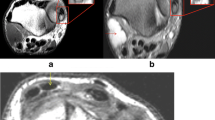Abstract
Objective
The symptoms and physical findings of intersection syndrome have been well described in the clinical medical literature. However, the magnetic resonance imaging (MRI) findings in patients with intersection syndrome of the forearm have only recently been described in a small number of patients. We review our experience with imaging of intersection syndrome, describe previously unreported MRI findings, and emphasize modifications to MRI protocols for its evaluation.
Materials and methods
Institutional review board approval was obtained for this retrospective review of patients with MRI findings consistent with intersection syndrome of the forearm during the period from January 2004 to September 2006. Six patients were identified, three males and three females, with an average age of 39.3 years. The MRI examinations were reviewed to assess signal abnormalities within and adjacent to the first and second dorsal extensor tendon compartments (DETC): tendinosis, peritendinous edema or fluid, muscle edema, subcutaneous edema, and juxtacortical edema. The overall longitudinal extent of signal alterations was measured as well as the distance from Lister’s tubercle to the crossover of the first and second DETC.
Results
Review of the MRIs showed increased intrasubstance tendon signal suggesting tendinosis in two of the six patients, peritendinous edema or fluid in all six patients, muscle edema in five of the six patients, and subcutaneous edema in three of the six patients. Juxtacortical edema was seen in one patient. Peritendinous edema or fluid extended distally beyond the radiocarpal joint in three of the six patients. The average distance from Lister’s tubercle to the crossover of the first and second DETC was 3.95 cm, in keeping with recently published data.
Conclusion
Intersection syndrome is an uncommon MRI diagnosis. In addition to the previously described MRI findings of edema adjacent to the first or second DETC, possibly with proximal extension and subcutaneous edema, we have identified additional abnormalities: tendinosis, muscle edema, and juxtacortical edema. In addition, our review shows that first and second DETC signal abnormalities in patients with intersection syndrome are not necessarily limited to the site of crossover but can extend distally beyond the radiocarpal joint. As standard wrist protocols may not include the area of intersection between the first and second DETC, coverage may need to be extended to the mid-forearm.





Similar content being viewed by others
References
Idler RS, Strickland JW, Creighton JJ Jr. Intersection syndrome. Indiana Med 1990; 83: 658–659.
de Lima JE, Kim HJ, Albertotti F, Resnick D. Intersection syndrome: MR imaging with anatomic comparison of the distal forearm. Skeletal Radiol 2004; 33: 627–631.
Browne J, Helms CA. Intersection syndrome of the forearm. Arthritis Rheum 2006; 54: 2038.
Servi JT. Wrist pain from overuse: detecting and relieving intersection syndrome. Phys Sportmed 1997; 25: 41–44.
Palmer DH, Lane-Larsen CL. Helicopter skiing wrist injuries. A case report of “bugaboo forearm”. Am J Sports Med 1994; 22: 148–149.
Pantukosit S, Petchkrua W, Stiens SA. Intersection syndrome in Buriram Hospital: a 4-yr prospective study. Am J Phys Med Rehabil 2001; 80: 656–661.
Dobyns JH, Sim FH, Linscheid RL. Sports stress syndromes of the hand and wrist. Am J Sports Med 1978; 6: 236–254.
Hanlon DP, Luellen JR. Intersection syndrome: a case report and review of the literature. J Emerg Med 1999; 17: 969–971.
Costa CR, Morrison WB, Carrino JA. MRI features of intersection syndrome of the forearm. AJR Am J Roentgenol 2003; 181: 1245–1249.
Parellada AJ, Gopez AG, Morrison WB, Sweet S, Leinberry CF, Reiter SB, Kohn M. Distal intersection tenosynovitis of the wrist: a lesser-known extensor tendinopathy with characteristic MR imaging features. Skeletal Radiol 2007; 36: 203–208, Epub 2006 Dec 20.
Grundberg AB, Reagan DS. Pathologic anatomy of the forearm: intersection syndrome. J Hand Surg [Am] 1985; 10: 299–302.
Author information
Authors and Affiliations
Corresponding author
Rights and permissions
About this article
Cite this article
Lee, R.P., Hatem, S.F. & Recht, M.P. Extended MRI findings of intersection syndrome. Skeletal Radiol 38, 157–163 (2009). https://doi.org/10.1007/s00256-008-0587-4
Received:
Revised:
Accepted:
Published:
Issue Date:
DOI: https://doi.org/10.1007/s00256-008-0587-4




